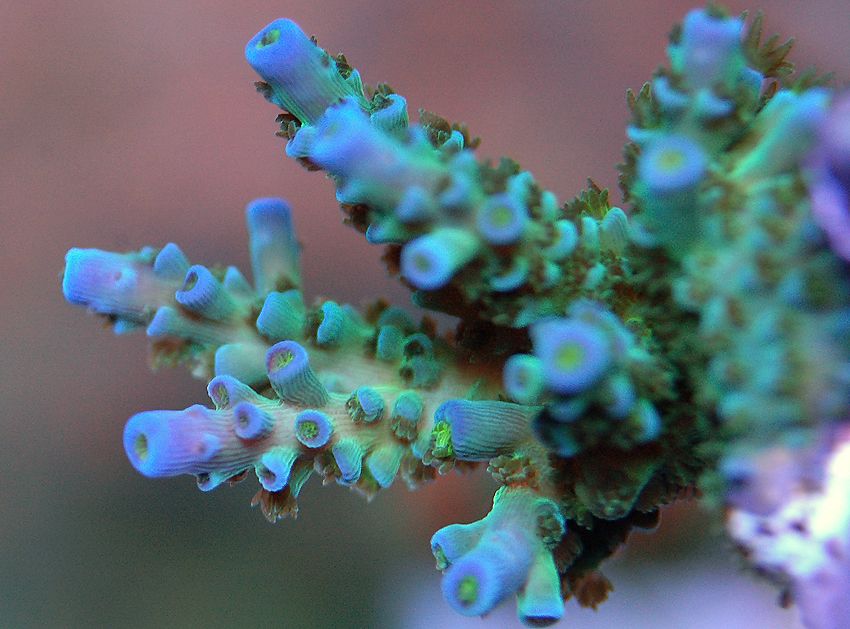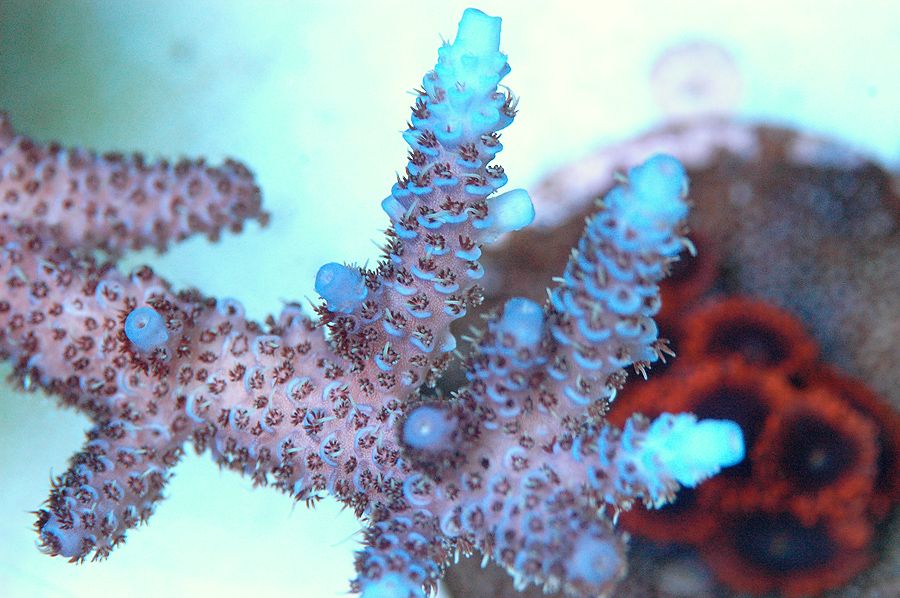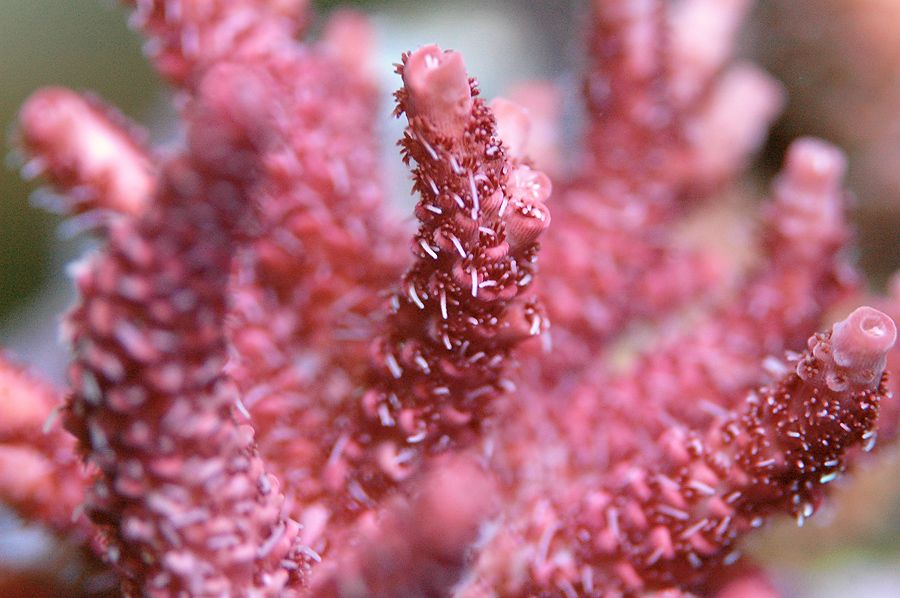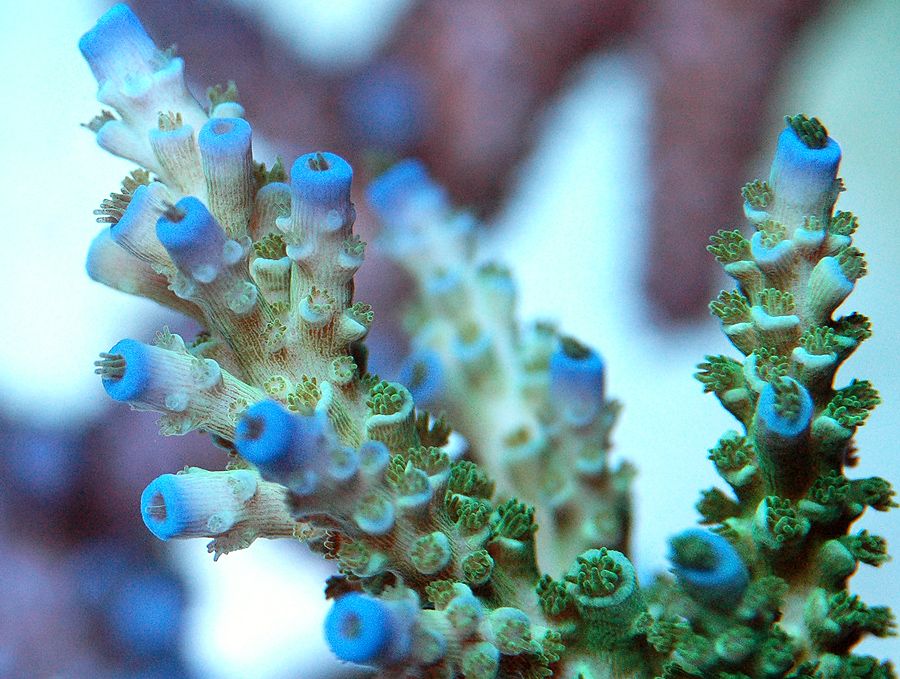


|
 |
|
|
#151 |
|
Registered Member
Join Date: Mar 2013
Location: Central NC
Posts: 5,062
|
Don't get me wrong - my tank is very far from eutrophic. I do go to the standard efforts to keep dissolved organic matter and mineralized nutrients to a minimum. Typical mineralized nutrient values are very near the detection limit of the tests, though presumably they are not zero. The idea is to keep mineralized nutrients to a minimum and nutrients in the form of small micro and macroscopic creatures available.
This is quite different than the goal when I started this addiction in the early 1990's. At that time, very few deliberately fed their corals anything other than the microscopic life that the tank would generate on its own. As you pointed out, there's no-one-size-fits-all for water conditions that will generate success for all of the corals we'd like to keep, and the general philosophy present in the early 1990's is pretty good evidence of that. Certain types of photosynthetes were pretty easy to keep and grow, but some of them were virtually impossible - goniopora is probably the best know example. |
|
|

|
|
|
#152 | |
|
They call me EC
Join Date: Apr 2007
Location: central Florida
Posts: 6,208
|
Quote:
http://www.reefcentral.com/forums/sh...ght=ecosystems I know it's a long thread, but it would probably be worth while for you to read it. If you don't have the time, check out post number 98, on page 4. It would be very, very difficult for you to retain your beliefs after reading the above thread. Peace EC
__________________
"Most of the failures with marine aquaria are due to lack of knowledge of the biological processes that occur in the aquarium." Martin A. Moe, Jr. "A scientist seeks the truth, wherever that may lead. A believer already knows the truth, and cannot be swayed no matter how compelling the evidence." Current Tank Info: I'm trying to see how many tanks will fit in my house before the wife loses it. |
|
|
|

|
|
|
#153 | |
|
Registered Member
Join Date: Feb 2007
Location: Santa Monica, California, USA
Posts: 2,511
|
Quote:
__________________
Inventor of the easy-to-DIY upflow scrubber, and also the waterfall scrubber that everyone loves to build: http://www.reefcentral.com/forums/showthread.php?t=1424843 |
|
|
|

|
|
|
#154 |
|
Registered Member
Join Date: May 2013
Posts: 242
|
If I'm understanding this correctly we want organic phosphates but not inorganic phosphates. I've read posts of people saying zooanthids/palythoas need some amount of phosphates and people always put a reference range of what they believe is good. Do zooanthids/palythoas use the inogranic phosphates too then or are people mistaking the organic phosphates which is not measurable, if I'm not mistaken, with the inogranic phosphate?
Any input would be greatly appreciated. I've gone thru a few pages of the posts and most deal with SPS, I'd like to know about the relationship between zoas/palys and phosphates as well.
__________________
Until there is sufficient evidence supporting your fish-craft, I don't agree with you. |
|
|

|
|
|
#155 |
|
Registered Member
Join Date: Feb 2007
Location: Santa Monica, California, USA
Posts: 2,511
|
All photosynthetic corals make "organic" phosphate from inorganic phosphate. The organic is glucose, and it is partially consumed by the coral, and partially released into the water to feed microbial laters, which are also consumed by the coral.
My favorite organic phosphate, however, is peanut butter 
|
|
|

|
|
|
#156 |
|
Registered Member
Join Date: Feb 2011
Posts: 2,919
|
A very interesting reed. Someone mentioned on page 5 about someone with stable parameters varying alkalinity for a few weeks to see what happened with the colors. I messed around with several things in my tank for two years. Searching for a clue to why frags would lose color and some would die within a couple of weeks. First I messed with light. Having access to a par meter, I found I was cooking them at 900 par... Lowering the light did not help...some palys responded well to lower light but not sps. Messing with alk levels did nothing as well. Too high i get rtn. To low i get rtn. Keeping them between 6-8 and no issues...Zero to no growth on all sps (except my purple stylo and green birdsnest)...I thought it could not possible be low nutrients because of all the great tanks out there with zero nutrients...
After about a year and a half with no growth... I mean NO growth...like the same 10 heads of zoas and a tank full of frags, I decided to feed heavily and get my nitrates up. Within a few weeks zoa heads were popping up, and frag plugs were getting encrusted. Within 3 months I was fragging some corals to keep them from touching. Within 6 months I frag monthly... Colors came back on 90% of my corals within 7 months...
__________________
MHG (LIRA Member) 60G Cube, Kessil 360's |
|
|

|
|
|
#157 | |
|
Registered Member
Join Date: Sep 2012
Location: Sooo St. Louis
Posts: 363
|
A couple of questions MHG cause I am going thru the same thing with very little growth. I test 0 Nitrates and 0 Phosphates and have started to feed more heavily mainly reef chilli, and frozen to my nems. I feed my fish pellets daily. I have went from 10 gallons every week to 10 gallons every two weeks. This is all an attempt to start detecting nitrates and phosphates. I do grow chaeto with other algae in the sump.
How much more did you feed? What was the par values for the zoas? Did you have any other forms of nutrient export? Skimmer? Biz Quote:
|
|
|
|

|
|
|
#158 | |
|
Registered Member
Join Date: Apr 2003
Location: Durham, NC
Posts: 739
|
Quote:
 corals need an initial source of organic N and P. we have been "told" by some that waste products of algae will provide this to our corals, not completely the case. corals need to be fed heavily, only those that are worried about nutrients will tell you otherwise. the bigger question is what is going on with waste products from all of that feeding. the corals have developed a symbiotic relationship with the algae/bacteria within them. they tightly recycle N and P amongst themselves, but there still needs to be constant input of new N and P for the corals to get the process started and bring in new building materials. the reason being is because readily available inorganic N, P, and CO2 are not readily available on a healthy oligotrophic reef. if it was, then the algae/bacteria would not need to live inside the coral. corals need an initial source of organic N and P. we have been "told" by some that waste products of algae will provide this to our corals, not completely the case. corals need to be fed heavily, only those that are worried about nutrients will tell you otherwise. the bigger question is what is going on with waste products from all of that feeding. the corals have developed a symbiotic relationship with the algae/bacteria within them. they tightly recycle N and P amongst themselves, but there still needs to be constant input of new N and P for the corals to get the process started and bring in new building materials. the reason being is because readily available inorganic N, P, and CO2 are not readily available on a healthy oligotrophic reef. if it was, then the algae/bacteria would not need to live inside the coral.  G~
__________________
Friends don't let friends use refugiums. Current Tank Info: Not dead yet. |
|
|
|

|
|
|
#159 | |
|
Registered Member
Join Date: Feb 2007
Location: Santa Monica, California, USA
Posts: 2,511
|
Quote:
Somewhere on RC is a big thread on feeding your corals so they will grow. |
|
|
|

|
|
|
#160 |
|
Registered Member
Join Date: Jan 2008
Location: Severn, MD
Posts: 1,579
|
Really great thread. I've been struggling with sps colors for a bit now and this topic hits home.
__________________
112g Cube 36x36x20= Custom 12x39wPower Module (Par Monster)= Neptune Apex=ATB 840v2=BM Doser= 2 MP-40's |
|
|

|
|
|
#161 |
|
Ultimate Reefer
Join Date: Apr 2002
Location: London, UK
Posts: 8,540
|
The answer to colourful SPS isnt a secret. Ask most of the old timers and they will say something like this:
1. Keep stable parameters: Alk, Ca, Mg, etc. I dont worry about Mg too much. I top up sometimes if required. But I maintain strict control on Alk and Ca by using a doser. A calcium reactor is perfectly fine as well. Even hand dosing is fine if you can do it daily every day. 2. Keep NO3 below 5ppm and PO4 around 0.03ppm I have seen these two parameters way higher in some tanks and SPS colours are still fine (take a look at member Big E; he has around 0.1ppm PO4, but excellent SPS colour), but usually PO4 is the one to keep a close eye on; not only because of SPS browning out, but to keep algae growth minimal. Use GFO in small amounts regularly. 3. Feed your tank generously. I think this is where a lot of people have issues. We dont feed our tanks as much as we should. With GFO, a decent skimmer and water changes in place you should be able to feed the tank generously and maintain parameters as set out above. Essentially you need HIGH INPUT + HIGH WASTE OUTPUT. Look through threads where the SPS are highly coloured (not pale like Zeo, but strong deep colouration) and if you ask the reef keeper about feeding they will usually tell you they feed their tank generously. 4. Carry out at least 10% water changes per week. Water changes are one of the best things you can do for your tank during the stage where you are trying to colour up your SPS and especially when your tank is less than 1 years old. 5. Run a decent skimmer for your sized tank. Pretty much easy enough. Keep it clean etc. Clean cup weekly. I clean whole skimmer every 3 months. 6. Run appropriate sized LED/T5/MH unit for your tank. As long as most SPS get around 200-250PAR they will colour up nicely. Some acros might need higher, but that generally is sufficient. 7. Stop messing with the tank; trying this potion and that potion. I think too many people miss the basics and start to mess around with additives; eg adding Amino Acids etc. This also means keep the hand out of the water as much as possible. Invest is a PAR meter if possible and after acclimating on the sand bed, moving to an appropriate place higher up on the rockwork has never caused me any problems. 8. Have patience. It usually take anywhere between 6-12 months of a tanks life before SPS start to colour up. If your rocks and sand are ultra clean and fresh then that period may be a lot shorter, but dont expect too much before that. It can take 6-12 months of water changes, using GFO and decent skimming to get the system clean enough for good SPS colour. That combined with the biological filtration maturing should set things up for nice colours. 9. Try and buy aquacultured frags. I have around 50/50 aquacultured and wild/mari pieces. On the whole, my cultured SPS colour up much more readily than the wild pieces. The above are like a collection of advice I have seen usually given by those who know the secret. Thats my experience as well. The secret isnt a secret. Its already out there. You just have to put the whole lot together and be consistent. Do that and your SPS will reward you with colours as what I have below:       If you search my current thread, I have a few more photos as well as photos taken with JUST camera flash and no other lighting so you can see that the colours are not just an effect of a particular style of lighting. I am no expert or SPS guru. I simply followed the basics of reefkeeping (geared towards SPS - eg higher flow and lighting etc). I do not run Zeovit, organic carbon dosing, Biopellets etc etc. Though these tools may be used, and will help, not usually required IMO. Stick to the basics. Keep it simple. PS I hope I dont sound arrogant or anything like that. I just wanted to highlight that its not difficult at all. Anyone can achieve it. |
|
|

|
|
|
#162 | |
|
Registered Member
Join Date: Sep 2012
Posts: 92
|
Quote:
|
|
|
|

|
|
|
#163 | |
|
Ultimate Reefer
Join Date: Apr 2002
Location: London, UK
Posts: 8,540
|
Quote:
 If you look at the systems of all the greats, there is nothing special that they do. And they will say do the basics its that simple. If you look at the systems of all the greats, there is nothing special that they do. And they will say do the basics its that simple. 
|
|
|
|

|
|
|
#164 |
|
Registered Member
Join Date: Oct 2009
Location: SoCal
Posts: 1,597
|
This thread has given me a lot to think about and reaffirmed what I already know. Thanks to everyone for contributing!
__________________
-Matt in between tanks |
|
|

|
|
|
#165 |
|
Registered Member
Join Date: Aug 2012
Posts: 399
|
I just want to say this is the best thread on RC. My tank is only 4 months old and I am still fine tuning the system. I started keeping SPS on day one. I have the same symptoms some of you have, pastel colored acros. After reducing alk from 8.7 to 7.8 the colors have darkened. I also started to feed heavily. Thank you.
|
|
|

|
|
|
#166 |
|
Registered Member
Join Date: Jun 2007
Location: eldon M.O.
Posts: 1,167
|
What about the lighting period?
Also would you say the 200-250par is the sweet spot i have leds over my 75g and im getting around 300-350par mid height were i will have my sps should dim my leds abit?
__________________
Jim its not a obsession its a way of life!--75g DT/125g sump/40g growout/30g frag/ATI sun power x8/t5 on DT/X2 D120 leds 40g/Sun blaze x4/t5 30g Current Tank Info: BubbleMagus(calc.,alk/Clearwater CW-300 Scrubber//56wAQUA UV/Reef Oct.SRO6000SSS Protein sk./1/10HP Chiller/GENESIS AWC |
|
|

|
|
|
#167 | |
|
Registered Member
Join Date: Jun 2012
Location: ludlow,PA
Posts: 605
|
Quote:
__________________
90 gallon display, CSC bean animal overflow/30 gallon sump (in basement) SWC 160 skimmer reeflow dart external pump reefkeeper lite a pair of ocean revive S026 led fixtures |
|
|
|

|
|
|
#168 | |
|
Ultimate Reefer
Join Date: Apr 2002
Location: London, UK
Posts: 8,540
|
Quote:
These are all just recommendations; you might find that 12 hours is too long and may even cause corals to lighten up etc. Or you might find the corals are just fine. With traditional lights (ie MH + T5) it was easier to say 8 hours MH and have 1 hour extra T5 or VHO Actinics before and after etc, but with LED's you have so many other variables such as dimming, channels, different colours etc so its harder to make individual recommendations. When I mentioned the 200-250 PAR I said that it is sufficient for most SPS to colour up nicely. Of course you can have slightly higher as long as it isnt causing your SPS to bleach; you are fine. Here is my lighting schedule on my T5/LED hybrid Sunpower: 12pm: ATI BLUE+, ATI Blue+ & ATI Actinic turn on. 1pm: Cree Royal Blue and Blue LED's turn on. 2pm: ATI Coral+ & ATI Purple+ turn on. 8pm: ATI Coral+ & ATi Purple+ turn off. 8.40pm: ATI BLUE+, ATI Blue+ & ATI Actinic turn off. 9pm: Cree Royal Blue and Blue LED's turn off. So you can see how I have staggered my lighting and that the tank receives FULL lighting for 6 hours, with an extra 3 hours of a combo of LED and T5. With respect to lighting; you need to watch your corals closely. A trick I use is to set your camera's white balance. Dont change it no more. Now change your lights for example you want to increase the PAR, increase it and then take a sample of 6-8 top down shots of your SPS. Then at the same time every 3-5 days after changing your lighting schedule or reducing intensity, take photos of the same corals. Now view them on the monitor//laptop screen. Has the colour improved? Has it stayed the same? Have some corals become paler? You get the idea. Or even get the other half to take mental shots and ask them to look at your corals again in a few days. YOU wont probably notice the subtle changes because you see the corals every day. You sort of have to "read" your corals. With SPS, Polyp extension, colour, general health of the SPS tissue (ie sometimes the flesh looks thin/dry looking if you go overboard on carbon dosing) are clues as to how they are doing. |
|
|
|

|
|
|
#169 | |
|
Go Spurs Go!!!
 Join Date: Dec 2004
Location: Meadowlakes Texas
Posts: 13,357
|
Quote:
__________________
Jack No One has ever been seriously injured by using the search function. Alcohol, Tobacco and Firearms should be a convenience store, not a government agency. Current Tank Info: Reefing the Pentagon. |
|
|
|

|
|
|
#170 | |
|
Registered Member
Join Date: Jun 2012
Location: ludlow,PA
Posts: 605
|
Quote:
i have a extreme brown SPS up top (about 4-6 inches from surface of the water) that has super green polyps on its base but its growing great! on the sand bed of have milis that are losing much color...my T5's all need replaced but i have 2 ocean revive S026 LED units showing up friday. i feel this should fix my light issue. i just dont know what else it could be? P04- 0PPM (hanna reader) alk - 8.3 cal - 440 MG - 1350 N03 - 0 i use dosers for alk and cal which are very consistent. it is a dirty tank (detrius in sand and rocks) and i have been using a turkey baster and filter socks to clean up.i just do not know what else to do? some frags on sand bed have STN on the base and have a very light color with little to no PE. i have dipped them with coralRX and found no pests. so i am replacing my old T5 unit with LED's better house keeping anything else i should do?
__________________
90 gallon display, CSC bean animal overflow/30 gallon sump (in basement) SWC 160 skimmer reeflow dart external pump reefkeeper lite a pair of ocean revive S026 led fixtures |
|
|
|

|
|
|
#171 | |
|
Ultimate Reefer
Join Date: Apr 2002
Location: London, UK
Posts: 8,540
|
Quote:
Keep going with the GFO usage, maybe use less but replace more often to help with the STN issues. Keep up the GFO usage, change it out as soon as the water gets higher than 0.03ppm. Keep an eye on the Alk if you are changing out lots of GFO every few days. Try and carry out 20% water changes at least twice weekly if you can for a month. Last edited by sahin; 11/10/2013 at 11:00 AM. |
|
|
|

|
|
|
#172 |
|
Registered Member
Join Date: Jun 2012
Location: ludlow,PA
Posts: 605
|
Ok, thank you!
 When testing p04, should i test the display water or directly from the GFO reactor?
__________________
90 gallon display, CSC bean animal overflow/30 gallon sump (in basement) SWC 160 skimmer reeflow dart external pump reefkeeper lite a pair of ocean revive S026 led fixtures |
|
|

|
|
|
#173 | |
|
Ultimate Reefer
Join Date: Apr 2002
Location: London, UK
Posts: 8,540
|
Quote:
Testing the effluent of the reactor will tell you when you need to change it ie that it is exhausted. But, if there are fines in the water, I've found in the past this causes errors in the test with photometers. Main thing is to be patient; it might take 6 months...and that is a very long time, but it will be worth it and you wont lose corals due to rushing things. Goodluck. 
Last edited by sahin; 11/10/2013 at 01:00 PM. |
|
|
|

|
|
|
#174 | ||
|
Registered Member
Join Date: Apr 2003
Location: Durham, NC
Posts: 739
|
Quote:
Quote:
G~
__________________
Friends don't let friends use refugiums. Current Tank Info: Not dead yet. |
||
|
|

|
|
|
#175 | |
|
Ultimate Reefer
Join Date: Apr 2002
Location: London, UK
Posts: 8,540
|
Quote:
Here is a quick breakdown of my tank: 47G tank with 30G sump. Bubble Magus NAC6 skimmer. Decent performance and adequate for my tank. Carry out 10% water changes per week. Mixture of liverock and Marco Key Largo rocks. The Marco rocks were treated beforehand for PO4 with LC and acid washing. I know the issue isnt these rocks. Liverock: I think here is the issue...my LFS sold me crappy old phosphate laden rock. I have NO sand. Barebottom tank. I siphone any detritus etc, change filter socks every few days etc etc. Run 2xMP10's on a 30inch long tank to keep detritus suspended etc. Fishes: 4 x Blue Chromis. 2 x Small Perc Clowns (around 2 inches is the bigger one. 1 x small Bangai cardinal. Those 7 fishes are small. Not a massive bioload like a small tang for example. I fed lightly for months thinking it was the food. I rinse all frozen food etc. So other than the liverock, I cant point anywhere else. Use an RO/DI unit. Change filter/DI resin when TDS hits 1. The main RO filter is less than 6 months old. Thats the thing...I tried to eliminate all the possible sources other than the liverock and still had phosphate issue for a long time. But things are better now because my SPS are coloring up nicely. But yeah I am still having to utilise GFO. |
|
|
|

|
 |
|
|